We Tried All the Pizza Ovens—Here Are the Ones We Liked
This article originally appeared on Outside
It used to be that there were three kinds of pizza: the frozen variety, those that arrived via delivery, or pies ordered and eaten at a restaurant. A small sliver of the pizza-loving population made their own, but that was an anomaly.
But, now, with the proliferation of affordable pizza ovens, the average home cook can eschew the frozen pie and easily fire up an artisanal one.
Piggybacking on the sourdough starter craze, homemade pizza has become downright trendy. And I have jumped on the bandwagon. My pizza journey began when I tried to parlay my sourdough skills into crave-worthy pies at home and found it easier said than done. This led to a nearly four-year exploration of making pizza, which included six different pizza classes across Italy.
If I've learned one thing from my journey, it's that amazing pies are most often born from pizza ovens. In order to achieve that crispy, cooked-to-perfection finish everyone dreams of, a pizza should be fired between 900degF and 1,200degF. This can only be achieved in a proper pizza oven, because home ovens max out between 500degF and 550degF. While you can certainly make serviceable pizza at home--especially if you have some good specialty tools--I don't believe you can make exceptional pizza.
Thankfully, there's a wide range of home pizza ovens that come in electric, propane, natural gas, and wood-fired options. Some are small enough to tote around, while others are a solid addition to the backyard and patio. I tested some of the best to help guide you to your pizza ideal.
The Best Pizza Ovens of 2023
Best for Camping
Gozney Roccbox, $499
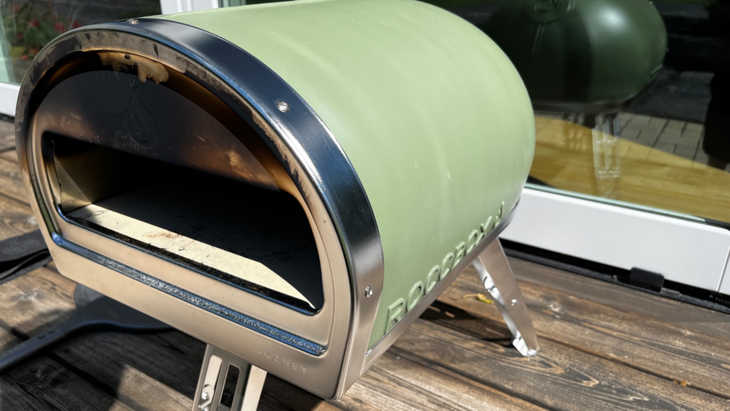
Gozney was one of the first to make pizza ovens for the home cook, and they do it about as well as it can be done. The Roccbox is one of my longtime favorite ovens, with serious power in a compact and uber-portable package. It has the option to be dual fuel with a quick exchange of the twist-off gas burner with the wood burner. The silicone exterior stays cool to prevent burning, and an exterior temperature gauge is accurate and easy to read. The Roccbox is simple to unpack and set up, and for max portability, it has a great wide Velcro sling with a handle. The stone needs curing - the curing process for the Roccbox is really simple, it just involves following the heating time instructions on the box, and takes about 30 minutes to complete. Once the 30 minutes is up, the stone is fully cured and the unit is ready to cook your first pizza. Once cured, you'll only need to heat the unit for about 15 minutes before cooking.
The Roccbox also has a limited-edition oven collaboration with chef and forager Brad Leone. The oven is a gorgeous sage green and has Leone's logo on it. It's the same price as the regular Roccbox, but I have to say, the color hits me where I live.
Best for a Crowd
ooni Koda 16, $599

The ooni brand was the first at-home pizza oven I heard of. When it comes to serving a crowd, we love the Koda 16. This unit uses propane or natural gas and can cook 16-inch pizzas, which is great when you have a lot of hungry mouths to feed. This was the easiest set-up of any unit I tested, as it’s out of the box and heating in under 10 minutes. While it's a two-person setup (the legs do not lock and the size makes it a bit unwieldy to set up alone), once in place, you can start rocking pizzas super-fast since the stone needs no curing. The oven yields truly spectacular thin and thicker crust pizzas. Ooni also makes some of our favorite accessories, though none of them come with the oven. The peels and IR temp gun are worth purchasing separately, and I'm obsessed with ooni's pizza topping station (see "The Best Pizza Accessories" below).
Best on a Budget
Solo Stove Pi Prime, $349
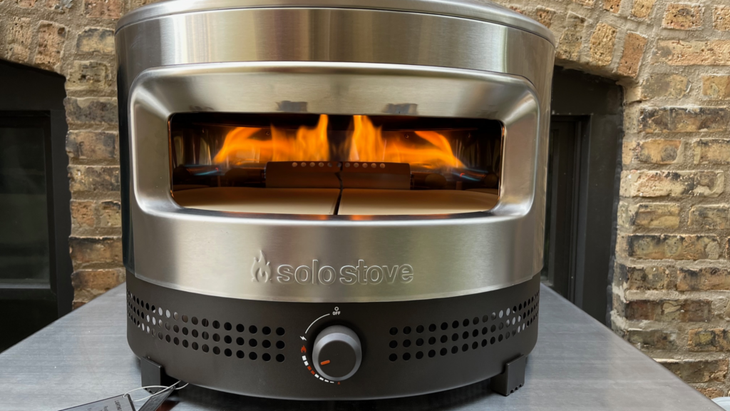
You might be surprised to see the wood fire pit company offer a propane-only pizza oven, but it makes this list because of the easy-to-setup. Unlike other Pi ovens that are dual fuel, the Solo Stove Pi Prime is propane-only, so it’s less expensive. But this doesn't mean the company skimped on function. This oven made pies equal to any of the more expensive ones I tried. I loved the wide opening for launching and turning, and though there are a couple hot spots in the back, they're pretty easy to avoid. The oven worked great for both Neapolitan and thicker crust pies, producing good leoparding with some welcome char and fabulous pepperoni cups. It's also crazy fast--one pie was done in barely a minute. Beyond its cooking capabilities, the oven is light and portable, making it a good choice for traveling. The company also has a cast-iron cookware set available to expand versatility for other foods.
Best for a Splurge
Gozney Dome, $1,999
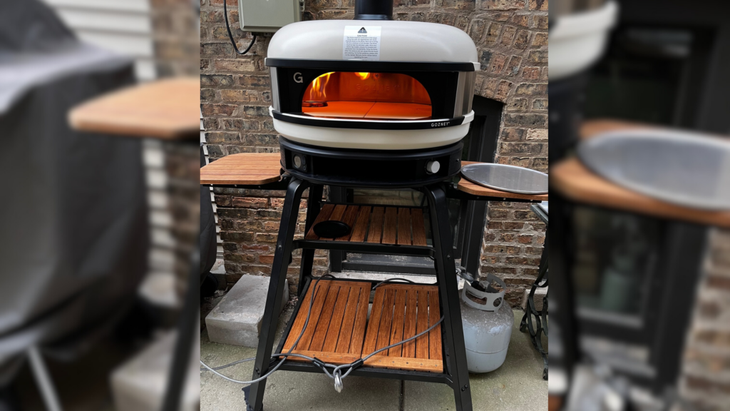
If you're serious about pizza and are willing to invest in a more permanent oven setup for your backyard or patio, the Gozney Dome is my splurge pick. And I do mean a splurge, because this gorgeous baby clocks in at nearly two grand. But if you're more than just an occasional pizza hobbyist, the price is unequivocally worth it. The oven has dual fuel for propane or wood burning and accessories like a Neapolitan Arch and Flue Extension, a steam injector, and a space for artisanal breads. It comes with a digital display and two food probes, making it versatile for foods beyond pizza. This oven can accommodate 16-inch pies, and we highly recommend the stand it comes with for extra stability. All in all, the Gozney Dome consistently made the best pies of any unit I tested. This is due to the size, the ease of launching and turning your pizzas, and the accessories that allow you to specialize the unit for specific types of pizza. This is the one to write home about.
Best for Backyard
Halo Versa 16, $549
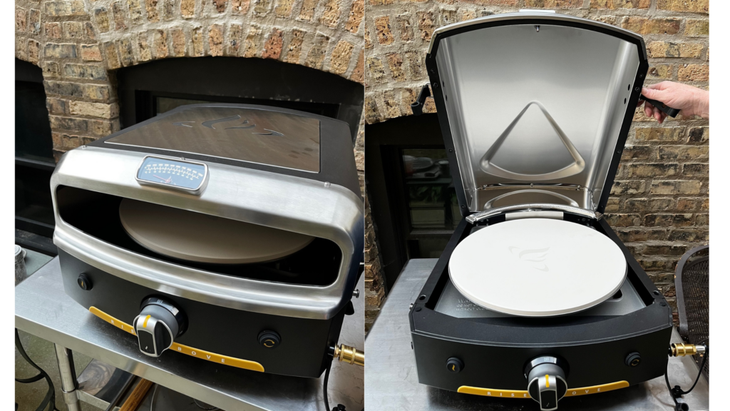
There are several reasons to recommend this unit from Halo, but what stands out most are the features that the other ovens on this list don't have. A propane-only unit, the Halo Versa 16 is the only oven I tested that comes with adapters for both 20-pound and one-pound propane tanks. It's larger than the Roccbox, and a bit unwieldy to carry, making it a good permanent fixture for the backyard. The first unique feature of the Halo Versa is a rotating stone, which eliminates the need to hand-turn your pizzas. Also, the booster burner under the stone helps get some good bottom crust crisping. It's a good idea to have the deck spinning while you preheat the oven, or you'll have a stone that's half hot and half cold. Once I got the turntable going, the stone evened out and the pizzas were grand. Stop the spin to launch your pizza, then restart once it is in there. My pizzas cooked fast and well, with good leoparding and just the right amount of char. And not having to turn them makes it great for families who have younger folks who want to help cook, because once launched properly onto the stone, it is a simple unit to use.
The reasons we prefer this for backyards are two-fold: Since it's so big, you must use the Halo Versa on a stable surface with excellent lighting. Launching pizzas onto the stone needs to be precise or you risk dumping part of your pie into the oven's inner workings. Additionally, the top lid is hinged and pops open for easy cleanup so you can fire it up on the regular.
Note that this oven takes some finesse to assemble and was the most laborious unit we put together. It took nearly an hour from opening the box to heating, and requires two types of batteries (neither of which are included) and a screwdriver of undetermined gauge. However, once assembled, the oven fired up quickly and made great pies. There is a cover available, which is recommended for storage. But take care when putting the cover on, it is easy to accidentally hit the turntable button and set it spinning.
Best for a Woodburning Experience
Bertello Grande 16, $549
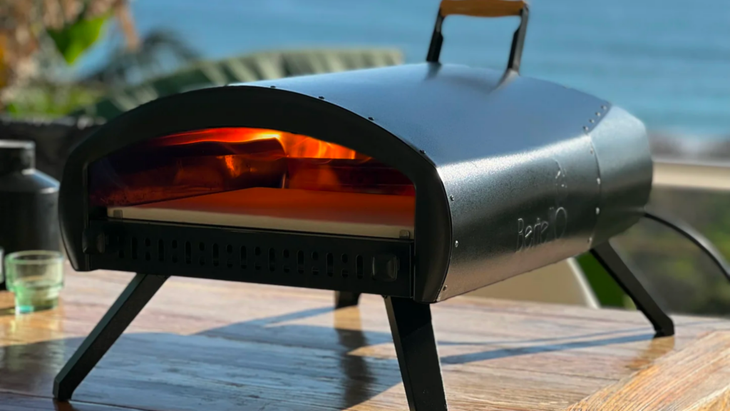
While many of these ovens have an option to switch from wood or propane, the Bertello is the only one that uses both simultaneously. An easy-to-load box at the back of the unit works with the Bertello wood kindling splits. You preheat the oven with propane, then drop in some wood and let the magic begin. This produced pizzas on par with our favorite ovens, with a little woodsy flavor. The propane burner is underneath the oven's deck, so you technically can get a ripping hot stone without adding wood. But with it, you get a gorgeous rolling flame across the top, adding surface char and terrific flavor. Be forewarned, this unit gets really hot, so while you can do those 90-second Neapolians, thicker crust pizza requires lowered propane so you don't get a crust that's burnt on the outside and raw in the middle. This is the unit we would pick if you most want to cook things in addition to pizza like steaks, chicken, or vegetables. If you crave wood-burning flavor, we cannot recommend the Berrtello Grande enough.
The Pizza Oven You Never Knew You Always Wanted
Witt Etna Rotante, $999
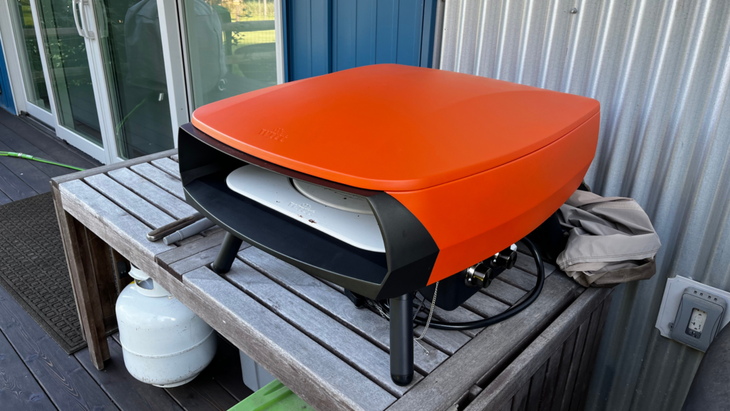
When you think of Denmark, your first thought probably isn't pizza. But Witt is about to change all of that. The company's new pizza ovens are just hitting the U.S. market after winning four design awards in Europe. I was one of the first to test these gorgeous ovens stateside, and it was love at first pizza oven. The propane-only unit has two burners: a U-shaped one that runs around the interior perimeter for even heating and cooking and a booster burner underneath the deck to heat the stone. But it's the turntable stone that makes all the difference in cooking exceptional pizzas. At the press of a button, the center of the deck turns slowly to perfectly cook pizzas--no additional help from you needed. And unlike the Halo, there is still a full stone, so there's no chance for accidental slippage. You don't need to have the stone turn to cook your pizzas, and the booster burner has its own control, so if you prefer those floppy in the middle Neapolitans, you can leave it off. A 16-inch pizza cooks in 90 seconds for thin crust and 3 1/2 minutes for thicker crust. You can also use a cast-iron pan to cook other things, which works well with the spinning deck. If you don't feel like the turntable deck is a must-have, Witt has a traditional one for $749 that has all the other same benefits. Both are currently available on Amazon and will be available directly on the company website in the coming weeks.
How to Make a Homemade Pizza
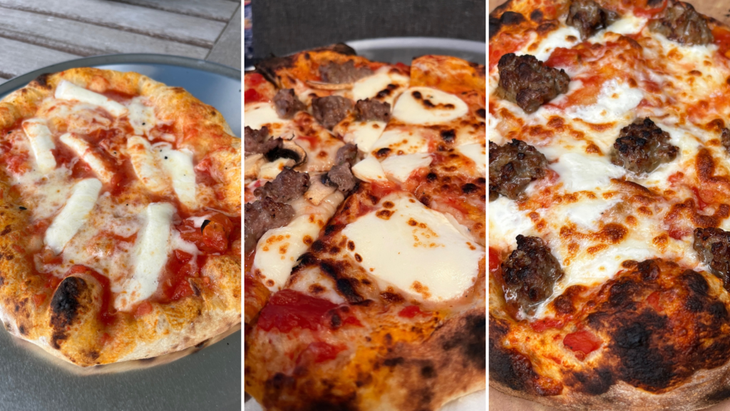
While a pizza oven is a feat of incredible engineering, delicious pizza requires more than just a medium to bake it in. When you begin making homemade pizza, it's nice to have some guidance. These are the top takeaways from my time learning the art of pizza-making in Italy.
1. Buy Pre-made Dough
First and foremost, you do not have to be a great crust maker to be a great pizza maker. Grocery stores sell perfectly good raw pizza dough, and many local pizzerias are happy to sell you their dough as well. Do not feel that you must go down the rabbit hole of doughmaking to have a wonderful homemade pizza. Having said that, if you do want to make your own, using actual Italian 00 flour, which is specially milled for pizza and pasta making, will make a major difference in flavor, texture, and elasticity of the dough. Companies like Caputo and Molino Grassi are widely available in grocery stores and online. If you cannot find Italian flour, King Arthur Bread flour is always dependable.
2. Encourage Stretchy Dough
Dough will stretch better if it has rested at room temperature for at least a couple of hours-- potentially longer if it's a cold day. If you roll dough instead of stretching, you may want to use a docker to prevent pie bubbles.
3. Bigger is Not Always Better
Though your oven might accommodate a 16-inch pizza, smaller pies are much easier to maneuver. Err on the side of 10- to 12-inch pizzas until you get the hang of launching and turning your pies.
4. Use Flour for Better Sliding
In pretty much all cases, straight old plain flour is the way to go for moving pizzas onto peels and into ovens. Don't use semolina and cornmeal, as they'll burn and smoke instantly. Semolina and cornmeal are great for home ovens, or pies that bake in or on pans, but if your pizza is going to cook directly on the deck, flour is the move because it allows easier sliding. One thing to note, however, is that just because a peel came with your unit, doesn't necessarily make it the best peel for you. Feel free to mix and match between brands to get the ideal setup. (See The Best Pizza Accessories below.)
5. Don't Pile on Toppings
It might be hard to restrain yourself, but minimize toppings when you can. Overloaded pies are hard to launch and might slop over onto the stone--which is difficult to clean. A thin coating of sauce and a mere scattering of toppings generally works best. Speaking of sauce, pre-cooked sauces do not do as well in pizza ovens compared to sauces that are made with canned tomatoes. Save the cooked or jarred sauces for pizza in your kitchen oven.
For pizza ovens, I recommend the sauce I made at the Molino Caputo flour company in a class with one of their most famous pizzaiolos, Davide Civitiello. (See Must-Have Recipes for Homemade Pizza below.)
6. Adjust Heat for Different Style of Pizzas
If you're doing Neapolitan-style pizzas, which have a bubbly crust rim but a softer middle, crank the heat up as high as possible and move the pizzas a quarter turn every 12-15 seconds to cook evenly. For pizzas that have thicker bottom dough, or if you want a crisper crust that stays firm when you pick it up, heat the unit super-hot to get the deck ready, but then turn the flame down before you launch your pizza. This will minimize burning the rim and toppings while the bottom cooks through. In general, Neapolitan pizzas will cook in about 90 seconds to 2 minutes; thicker pies closer to 3 1/2 or 4 minutes.
Whether your unit has an external temp gauge or not, you will want an infrared thermometer gun. The deck temperature is as, if not more, important than the ambient heat. Be sure to check the temp of your stone in a few places so that you can anticipate hot spots.
7. Be Patient When Preheating
You will almost always want to let the oven preheat longer than the manufacturer states. Thirty minutes seems to be the sweet spot for all propane units. The exception to this is if you're working with premade pizzas, which generally take 15-20 minutes to bake. You can cook pre-made pizzas or pizzas made with store-bought cooked crusts in all of these ovens very successfully. Thaw frozen pizzas overnight in the fridge, as cooking from frozen risks thermal shock to the stones and they can crack. Heat your unit on the low setting and for less time than for truly raw pizzas and keep them turning to prevent burning. In all of these cases the crust is cooked or par-cooked and you are mostly warming it through and crisping and cooking the toppings, so if you see the edges start to burn, use the peel or turner to lift it up off the deck to finish the toppings.
Must-Have Recipes for Homemade Pizza
Pizza Sauce
Sometimes the best pizza sauce is also the simplest. My recommendation is this: For every four pizzas you want to make, take one 15-ounce can of whole peeled canned San Marzano tomatoes, crush by hand, and season with salt and pepper. That's it. That's the whole recipe. And yes, splurge on the fancy San Marzano DOP tomatoes. Their natural sweetness and the wonderful texture make a major difference, as they are less watery and have fewer seeds than other tomatoes. It should just taste like a bright, fresh tomato enhanced with seasoning. When you first start, resist the urge to zhuzh, you'll be amazed how well this works. But obviously, if you want to add things like red pepper flakes for heat, or some dried herbs for depth, follow your intuition.
Pizza Dough
As I mentioned, there is perfectly good quality pre-made pizza dough available pretty much everywhere these days, and even some good frozen options. Having said that, there are some simple doughs that anyone can make without difficulty. My favorite is a two-ingredient recipe. I combine equal parts by volume of whole milk Greek yogurt and self-rising flour. The natural acidity of the yogurt activates the leavenings in the flour and you get an easy-to-work-with dough that is great for any pizza or flatbread, with some tang that imitates sourdough. You will have to roll this dough (not stretch) and it doesn't rise. For every 10-12 inch pizza, you'll need 1/2 cup yogurt and 1/2 cup self-rising flour. (You may want to also add a pinch of salt.) Multiply up as needed.
Pizza Dough for Camping
If you want to make a batch of dough while out on the trail, you can make this dough in a bag. You'll need 2 1/2 cups of flour (all-purpose will work, but seek out Italian 00 flour if you can--Caputo and Molino Grassi are both brands that are available stateside), 1 1/2 teaspoons of fine sea salt, 1/4 teaspoon of sugar, and a packet of yeast. Put all your dry ingredients in a gallon Ziploc bag. Give it a shake, then pour in 1 1/4 cups lukewarm water. Close the bag and mush around until you have a cohesive dough. Set aside for 30 minutes to 2 hours, then remove from the bag, give a quick knead on a lightly floured surface, and mold into two to three balls for your pizzas. This dough works best when rolled versus stretched.
The Best Pizza Accessories
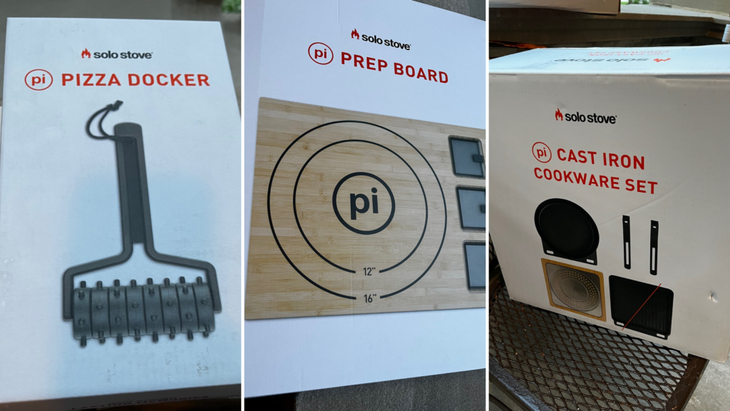
Here are my favorite tools and accessories for killer pizza at home.
Peels: a tool that allows you to slide a pizza into an oven without burning yourself.
I really love the Gozney perforated peel for most of my pies because it slides well and comes with both short and long handles. For another solid peel, Epicurean makes one of pressed wood that is dishwasher safe.
Turner: a tool that can pick up the pizza and rotate it while it cooks.
Again, Gozney has my pick for the best turner. It's pretty much identical to the ones I learned with in Italy, and comes in two lengths, so you can pick the one that best fits your needs.
IR Thermometer: an easy measure of heat that uses a lens system so you don't have to stick your hand into the oven with a thermometer.
I like the Gozney IR gun because it's accurate, fast, and small enough to fit in my apron pocket.
Prepping Tools: any tool made to prepare pizza dough or toppings.
Babadoh dough containers make prepping and storing those perfect dough balls super simple. As silicone molds with lids, they keep your dough round, and the balls are easy to pop out.
Ooni Pizza Topping Station is another one of my favorite tools. It has two large and four small containers for your sauce, cheese, and toppings, and has seal-tight lids for storing in the fridge. The tilted holder keeps everything at the perfect angle for fast pie prep.
Baking Steels and Stones: flat sheets or plates that improve your oven's evenness of heat.
If you don't have a pizza oven, you can use the Baking Steel on your grill, kamado, or in your kitchen oven. And, to go along with that, Fibrament makes my favorite baking stone.
Cutters: a tool to precisely and finely cut your pizza.
There are three ways I like to cut my pies, depending on the style. For large pies that cry out for wedges, I lean on the Love This Kitchen Pizza Rocker. It can handle the big boys easily and quickly. When I want to cut into thinner slices or squares, I really love this Boska Pizza Roller, which is also a useful tool for general pastry work. And for thicker pizzas, focaccias, and flatbreads, I love the Ciselier 8 inch Alpen Italiano Classico shears, which make fast work of slicing any size of piece, and come apart for easy cleanup.
Skillet: a type of frying pan with a deep base, used for cooking your pizza toppings.
Cooking in your pizza oven requires cast-iron accessories. I love this Victoria 13-inch skillet with double loop handles, which can take on a spatchcocked chicken, a pile of fingerlings, or a perfect paella. Safe for temps up to 1,000degF, it's a versatile skillet for your kitchen or your pizza oven.
Serving Tools: any tool used to serve your pizza.
When it comes to serving your pies for a crowd, I love a gorgeous presentation. The Stella Falone reversible large cutting board is visually stunning and you get a great non-slip mat to put underneath. I like that it can show off a large pizza or flatbread and still have room to wrangle little bowls of parmesan, olive oil, oregano, or red pepper flake shakers. If you want a round server to highlight your pie, try the Tondo natural wood server from Crate & Barrel, it comes in four colors and can hold up to a 16-inch pizza. And, finally, if you're serving individual 10 or 12-inch pizzas, that classic Fiesta from Homer Laughlin has a 12-inch plate in a variety of their fun colors.
For exclusive access to all of our fitness, gear, adventure, and travel stories, plus discounts on trips, events, and gear, sign up for Outside+ today.

